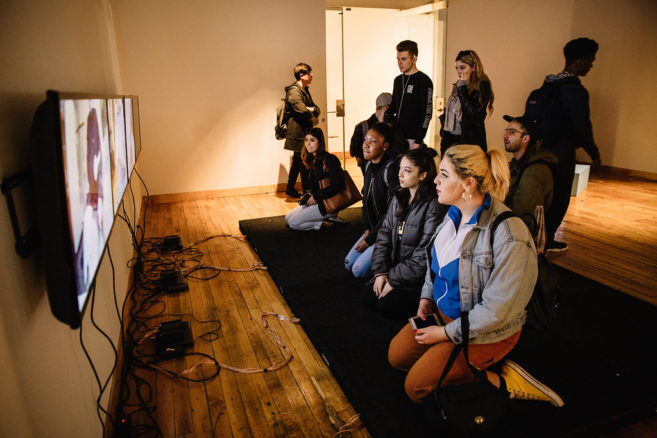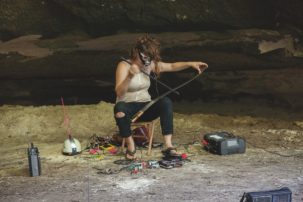Last November, Canadian Art editors, contributors and artist facilitators participated in Canadian Art’s School Hop, an initiative started in 2003 to address the diminishing funding of arts programming in the public education system. Led by Toronto-based multidisciplinary artist Basil AlZeri and Canadian Art contributing editor and director of programs Nicholas Brown, these sessions give students access to a thriving, local art scene. They demystify the realities of working as an artist and offer a different perspective on how art can be manifested and presented for students interested in exploring art as a career choice.
School Hop is unique in that it offers insight into the different stages of an artist’s career, from emerging-student to late-career. “I truly enjoy leading School Hop,” says AlZeri. “There is much value in introducing students to contemporary art through visual learning and critical thinking.” With the addition of the Young Critics program, which solicits critical responses from students for publication in Canadian Art, School Hop is able to provide a more robust and meaningful experience. Last year, Canadian Art editorial resident Vidal Wu, an alumnus of Central Technical School (Toronto), was paired with current students from their prestigious Art Program. The students’ responses to the exhibitions they toured together are featured in this article.
With School Hop we brought Central Tech students to Xpace Cultural Centre, a not-for-profit artist-run centre (supported by the OCAD University Student Union) to view “Installation as a Subversive Act,” curated by Katie Kotler. This exhibition asked how the fantasy constructed by film sets can be produced in a gallery setting, and, subsequently, best enjoyed. As the students walked in, they were greeted by Kitchen Set (2017), a cartoonish mise-en-scène of a kitchen by Cotey Pope and Maddy Matthews done in bright pastels and constructed on cheap, two-dimensional cardboard, which created a flattened effect. The students immediately picked up on some dominant themes: artifice, commercialism and domesticity. “The work is almost sinister; elements of reality are there but are the wrong shapes, the wrong colours and lack the depth of the natural world. It morphs from peaceful to ominous the longer you are in its presence,” writes grade 12 student Jamie Kirton. “Is the artwork supposed to relive childhood memories or to idealize a mundane situation? Is it a play on a little child’s toy kitchen?”
At the rear of the gallery, Jamiyla Lowe’s A Whole New World depicted a fictionalized society on the brink of cataclysm. The series of compositions revolved around four central themes—sensuality, environmental entanglement, scarcity and political apathy—to allegorize the relationship between the body and the environment. The dense imagery of Lowe’s work provoked surprising reflections from the students. In The Beach, two figures embrace on a beach, while on the horizon volcanoes erupt against a pitch-black sky, a heteronormative cliché from cinema wrought wild as the otherworldly figures morph into a single form.
“This work reminds me of my own experiences with sensuality,” writes grade 11 student Sage Grosbein Ainslie. “I’ve never felt a sense of peacefulness with another person before, and I don’t know if anyone actually has or of that event exists. Maybe it’s just something we all want but never actually achieve. Maybe it’s something we have to create for ourselves. But, realistically, it probably doesn’t matter because we’re all going to die eventually.” Melodramatic, yes, but the point is well made. Birth begets death, and vice versa.
At Daniel Faria Gallery, students were treated to Mark Lewis’s exhibition “Anniversary,” which attempted to reconcile our understanding of Canada’s sesquicentennial with challenging personal legacies and collective histories. Immediately, students were entranced by Arrival (2017), a single, slow, invisibly choreographed shot of Newfoundland and Labrador’s Gander International Airport, which Lewis calls a minor modernist masterpiece. Known at one time as the “crossroads of the world,” Gander was not only the place where virtually every transatlantic flight stopped to refuel, but it also served as an advertisement for Canada as a modern, forward-thinking country.
Students picked up on the parallels between the hidden agenda of Gander International Airport and Canada 150. Grade 11 student Anna Moller notes that while the airport implies modernity and reinvention, it also served as a hub for the illegal transport of prisoners from Guantanamo Bay and other secret C.I.A. torture sites. “It is astounding to imagine these prisoners with their hands and feet bound, their head covered, being led across the floor of this modern lounge,” she writes. This point draws attention to the issues raised by Indigenous activists during the revisionist Canada 150 campaign: the arbitrary seizure of lands, access to clean water compromised by industrial intervention, and cases of murdered and missing Indigenous women abandoned by the authorities.
Arrival (2017) shows a mirrored image of an entrance to the Gander International Airport collapsing inward, the eerie manipulation of the image undermining the cheery promise of intercontinental travel. “It almost seems like a mouth is closing around its prey, or like a gate closing, which is ironic for an airport gate since it’s usually something that is always open or welcoming,” Moller continues. Eventually, people move through the gate; however, on closer inspection, the figures are reversed, while walking in reverse, a play on the contradictions of Canada’s open-arms public image and the virtually “whites-only” immigration policies of the time.
Students were also introduced to Akin Collective, a Toronto-based arts organization that hosts affordable studio space, arts-based programming and professional development workshops for artists. In addition to providing a community-oriented space, Akin pays particular attention to the support toward furthering one’s art practice. With members ranging from 16 to 70+ years old, the art-making that happens at Akin hardly needs institutional approval or education to exist, making resources accessible to a diverse community.
The Art Centre at Central Technical School, established in 1915, is housed in a fabulously modernist Brutalist structure on Lennox Street, the very first art school in the Toronto public school system. Equipped with facilities virtually unseen in public schools elsewhere—a copper studio, kilns, screenprinting and sculpture studios—the building has the capacity of a program many times its size, but is underused due to chronic underfunding and a renewed focus on sports. As an alumnus of Central Tech, and more importantly, the art program, I’m saddened to see a one-of-a-kind program fall to the wayside when just across the campus the Central Tech Blues, a famously bad football team, practices in the brand new indoor football field that looms over the corner of Harbord and Bathurst.
The Central Tech Art Centre has experienced its own setbacks: declining enrolment, slashed budgets and fewer teachers for more students. Keeping arts programming alive is crucial. Building publicly accessible facilities like the Art Centre needs to be a priority now and in the future. The reality that there are few venues for young people to experience, contemplate and discuss art in a serious, thoughtful manner. Arts programs are always the first to go in favour of more “practical” endeavours, even while now, more than ever, there is a need for critical thinking and a desire to engage with contemporary art. School Hop is a temporary solution for a larger problem, one that can be addressed through partnerships between institutions, education boards, community organizations and invested patrons.
Student responses have been edited for clarity.
Vidal Wu was Canadian Art’s 2017 editorial resident. He tweets @vidalwuu.








